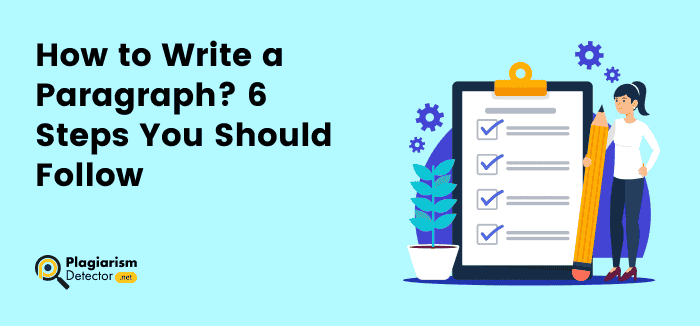How to Write a Paragraph? 6 Steps You Should Follow

To write a paragraph, understand the paragraph, plan, start writing, proofread, edit and finally use automating the process to write a standout paragraph.
How do you write the paragraph, and what components should it include? If yes, you have navigated to the right spot. Good paragraph writing is undoubtedly a challenging task. You must ensure you cover all the requirements within a specific sentence limit.
How to Write a Paragraph in 6 Steps
Newbie writers and students need help with this. However, there’s no need to overwhelm yourself and rack your brain. This short guide will illustrate paragraph writing steps in detail, which can be implemented practically. So, let’s dive into the details without wasting time and explore the six steps to writing a paragraph.
Step 1 – Understanding Paragraph Writing
Before beginning the paragraph writing process, it is vital to understand what a paragraph is, its essential components, and the types of paragraphs. You can excel at the task by having a clear idea of paragraph writing.
A paragraph is a self-contained writing block containing multiple sentences on a similar topic organized coherently. In simpler terms, it is a section on a specific idea with relevant sentences. A paragraph usually comprises three components: a topic sentence, a few supporting sentences, and a concluding sentence.
Step 2 – Planning
Before any writing process comes the planning and creativity step, as you must first know what you will write and how to write it.
Planning begins with understanding your topic idea. Write the topic idea in broad fonts and size on a plain document. Stare at it for a few minutes and interpret what the topic is all about. Understand the requirements to satisfy the topic’s demands.
Step 3 – Start Writing
Start writing the paragraph by first writing a word, followed by a phrase, and completing the sentence. Now, write a sentence-by-sentence explanation to conclude your paragraph.
The opening or topic sentence is the first sentence that delivers the topic idea for the entire paragraph. It should be written clearly and concisely and cover the central concept comprehensively.
Step 4 – Proofreading
When you write a paragraph, it is necessary to critically review it. Thoroughly proofread it and ensure you have covered all the vital details, described the issue effectively, followed a proper structure, made no mistakes, and offered originality. Start check-marking them one by one, as suggested below.
Structure
Start with the structure to analyze the overall impact your written work has. Have a general look at the formatting and length of sentences. Do they look coherent? Ensure all the sentences have the exact average words. For instance, if your topic sentence is between 12-16 words, all the supporting sentences should be the same length. Avoid writing a sentence within ten words and another with more than 25 words.
Grammar
Proofread to make sure your paragraph is grammatically accurate. Your paragraph should fulfill all grammatical rules. Start by looking for minor errors like punctuation and typos. Then, move to sentence making and structuring. The subject, object, verb, nouns, and adverb, in short, every component should be written as per rules. It would help if you also watched for the readability and comprehension of the paragraph in this step.
Originality
Although proofreading doesn’t include verifying originality, you can use it while reviewing. Your written work should be unique, even a small paragraph. Authenticate your paragraph’s originality by manually comparing it with the inspirational source. Or use a reliable content detector. An AI plagiarism checker can actively vouch for the probable instances of ChatGPT content generation. Moreover, it will also provide you with the URLs of the matched sources to rectify them.
Step 5 – Editing
After thoroughly checking, make amendments to your paragraph. You can start with simple edits and then rewrite for significant changes.
Fix Errors
Rectify spelling and punctuation mistakes as you identified in the previous step. Additionally, change any complicated or jargon words. Such types of words compromise the readability and ease of understanding. Therefore, it is better to change them and improve their comprehension. Similarly, simplify the compound or other sentences that affect the paragraph’s readability.
Rewrite
The paragraph rewriter by PlagiarismDetector can effectively transform your paragraph into a more meaningful and engaging version. It replaces unnecessary words with better synonyms and alters the sentence structure to make it more appealing and easily readable. The paragraph rewriter is a sure way to deliver a revitalized paragraph. Furthermore, it also avoids the chances of plagiarism.
Step 6 – Automating Process
Though this step can be a standalone procedure, this comes as the last step. You can write the paragraph by following the steps mentioned in an hour or more. But do you know you can remove all five paragraph writing steps and craft a precise paragraph in a single step?
Yes, you can do this with the aid of a paragraph generator. But here’s the take: Don’t rely on any online paragraph generator; choose a credible platform. The PlagiarismDetector offers a competent and proficient generator that can provide a flawless paragraph by simply providing the topic.
Conclusion
These six simple steps help you write a paragraph considering all its requirements. Whether you have to write one paragraph on a topic or multiple, you can find them valuable and beneficial. Always ensure that you follow an appropriate structure for paragraph writing that includes a topic sentence, supporting details, and a concluding sentence.




